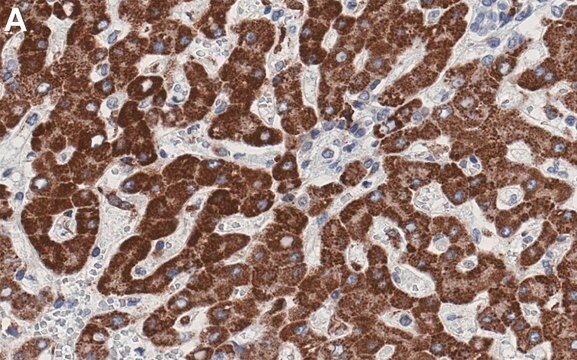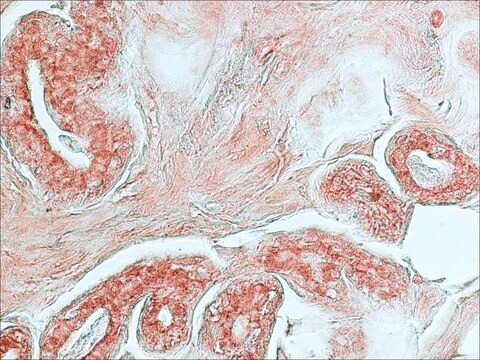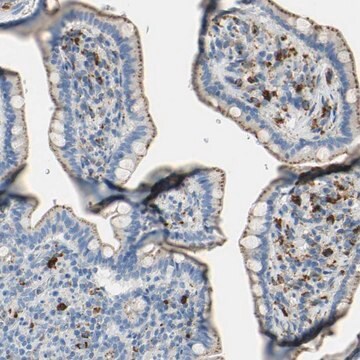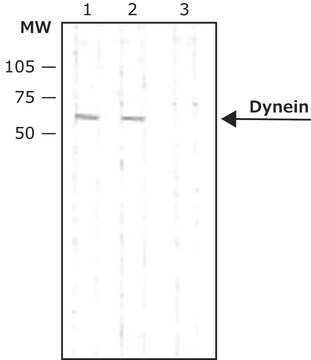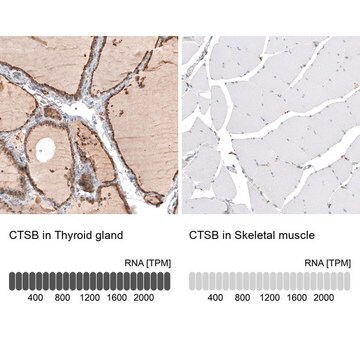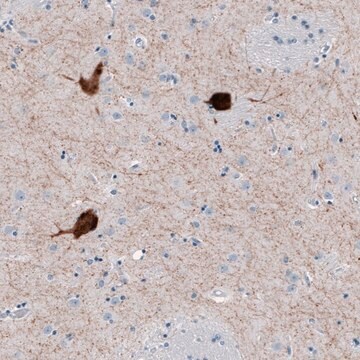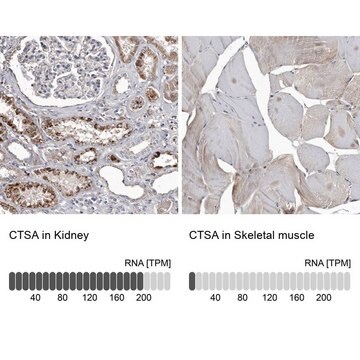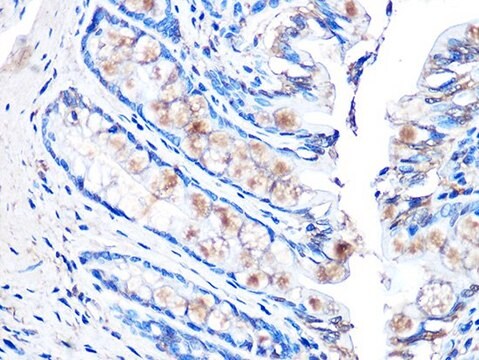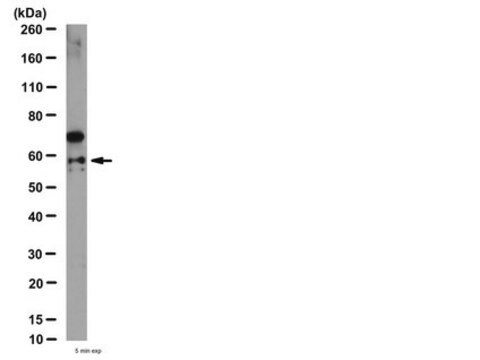おすすめの製品
由来生物
mouse
品質水準
抗体製品の状態
purified from hybridoma cell culture
抗体製品タイプ
primary antibodies
クローン
CTD-19, monoclonal
フォーム
buffered aqueous solution
交差性
human, rabbit
濃度
~1.0 mg/mL
テクニック
immunoblotting: 2-4 μg/mL using human breast cancer MCF7 cell line
immunofluorescence: 5-10 μg/mL using HeLa cells
immunohistochemistry: 10-20 μg/mL using heat-retrieved formalin-fixed, paraffin-embedded human liver sections
アイソタイプ
IgG2a
UniProtアクセッション番号
輸送温度
dry ice
保管温度
−20°C
ターゲットの翻訳後修飾
unmodified
遺伝子情報
human ... CTSD(1509)
詳細
Anti-Cathepsin D antibody, Mouse monoclonal (mouse IgG2a isotype) is derived from the CTD-19 hybridoma, produced by the fusion of mouse myeloma cells and splenocytes from BALB/c mouse immunized with cathepsin D purified from human liver. Cathepsin D (CatD or CTSD) is synthesized in the rough endoplasmic reticulum as pre-proprotein. After removal of signal peptide, the pro-CatD is targeted to endosomes to form an active, ~48 kDa, single-chain intermediate then to the lysosomes to form the fully active mature protease, composed of a ~30 kDa heavy chain and a ~14 kDa light chain.
免疫原
Cathepsin D Purified from human liver
アプリケーション
Anti-Cathepsin D antibody, Mouse monoclonal has been used in:
- immunoblotting
- immunohistochemistry
- immunofluorescence
生物化学的/生理学的作用
CatD plays numerous physiological functions in the cells including metabolic degradation of intracellular proteins and the activation of enzymatic precursors. In the central nervous system, CatD is particularly important for the control of neuronal homeostasis, cell migration and interneuron communication. CatD-mediated proteolysis mediates the degradation of unfolded/oxidized protein aggregates in lysosome. The level of CatD synthesized by the cells is increased in response to mitogenic signals from estrogen, epidermal growth factor (EGF), fibroblast growth factor (FGF), and insulin like growth factor-I (IGF- I). The ability of tumor cells to invade the extracellular matrix has been attributed to cathepsins released by tumor cells or associated with its plasma membrane.
物理的形状
Solution in 0.01 M phosphate buffered saline, pH 7.4, containing 15 mM sodium azide.
適切な製品が見つかりませんか。
製品選択ツール.をお試しください
保管分類コード
10 - Combustible liquids
引火点(°F)
Not applicable
引火点(℃)
Not applicable
適用法令
試験研究用途を考慮した関連法令を主に挙げております。化学物質以外については、一部の情報のみ提供しています。 製品を安全かつ合法的に使用することは、使用者の義務です。最新情報により修正される場合があります。WEBの反映には時間を要することがあるため、適宜SDSをご参照ください。
Jan Code
SAB4200767-BULK:
SAB4200767-VAR:
SAB4200767-100UL:
M J Duffy et al.
Clinical chemistry, 37(1), 101-104 (1991-01-01)
Cathepsin D (CD, EC 3.4.23.5) is a lysosomal protease induced by estrogen in certain estrogen receptor (ER)-positive breast cancer cell lines but produced constitutively by ER-negative cell lines. Our aims in this investigation were to study the distribution of CD
Nuclear cathepsin D enhances TRPS1 transcriptional repressor function to regulate cell cycle progression and transformation in human breast cancer cells
Bach AS, et al.
Oncotarget, 6(29), 28084-28084 (2015)
Cathepsin D as a therapeutic target in Alzheimer's disease.
Di Domenico F, et al.
Expert Opinion on Therapeutic Targets, 20(12), 1393-1395 (2016)
The role of cathepsin D in the pathogenesis of human neurodegenerative disorders
Vidoni C, et al.
Medicinal Research Reviews, 36(5), 845-870 (2016)
Veronika Stoka et al.
Ageing research reviews, 32, 22-37 (2016-04-30)
Lysosomes and lysosomal hydrolases, including the cathepsins, have been shown to change their properties with aging brain a long time ago, although their function was not really understood. The first biochemical and clinical studies were followed by a major expansion
ライフサイエンス、有機合成、材料科学、クロマトグラフィー、分析など、あらゆる分野の研究に経験のあるメンバーがおります。.
製品に関するお問い合わせはこちら(テクニカルサービス)